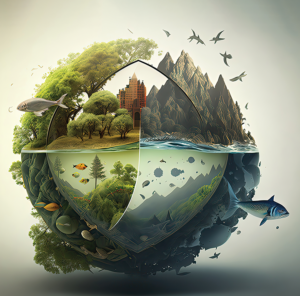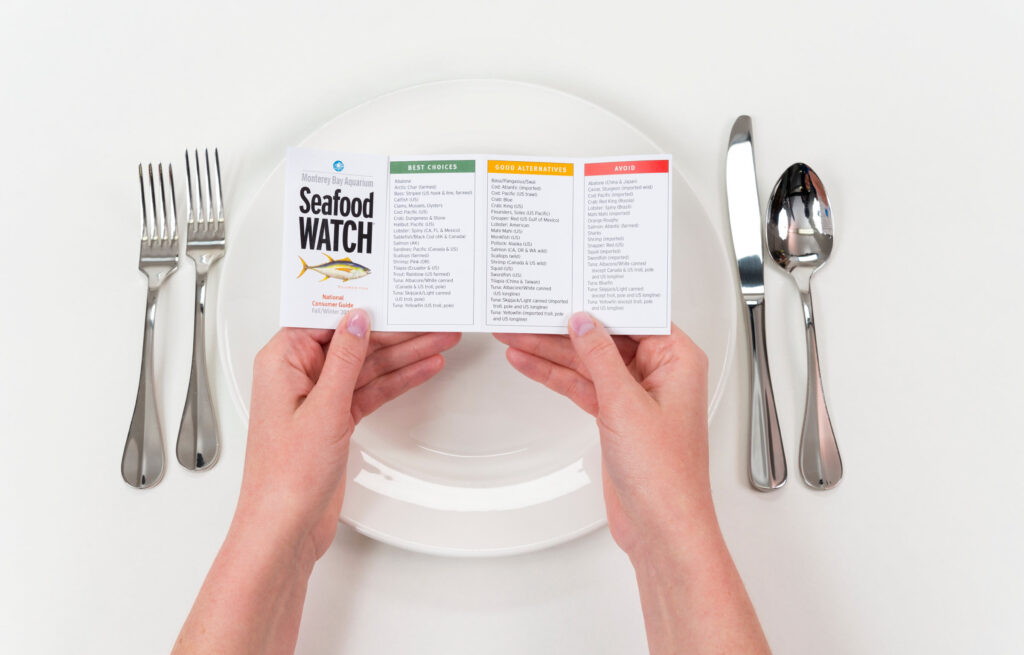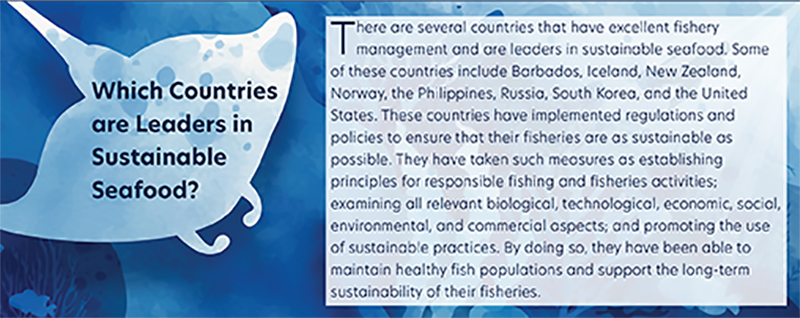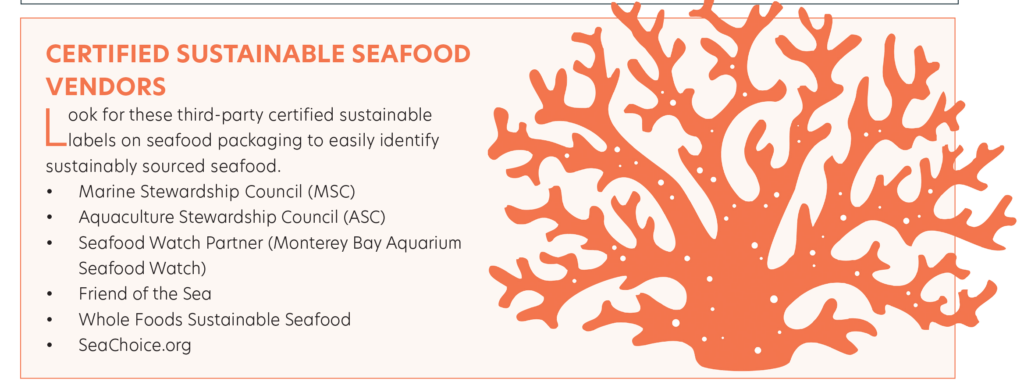 What is blue food?
What is blue food?
According to the United Nations Committee on World Food Security, we must move the current global food systems “…from a singular focus on increasing the global food supply through specialized production and export, to making fundamental changes that diversify food systems, empower vulnerable and marginalized groups, and promote sustainability across all aspects of food supply chains, from production to consumption.”1
Aquatic ecosystems, including oceans, seas, rivers, and lakes, are home to a vast diversity of species that can be valuable sources of nutrients—these nutrient sources are known as blue food. Blue food, as a defined concept, has been gaining attention recently as a means to promote the sustainable use of aquatic resources to support healthier and more equitable food systems globally. Blue food includes various fish species, shellfish, seaweeds, algae, and other microorganisms.2 Incorporating these aquatic resources into our diets has several potential advantages:
Diverse nutrient-rich foods. Blue food can provide a wide range of essential nutrients, such as omega-3 fatty acids, vitamins (e.g., A, D, B12), minerals (e.g., iron, zinc, calcium), and high-quality protein. By diversifying our food sources, we can reduce the risk of nutrient deficiencies and improve overall health.2,3
Sustainable food production. In many cases, aquatic food sources can be more sustainable to produce compared to traditional land-based agriculture. Well-managed fisheries and responsible aquaculture practices can have a lower environmental impact, such as reduced greenhouse gas emissions, land use, and freshwater consumption.4
Feeding more people. With the global population continuing to increase, finding sustainable ways to feed the growing number of people is crucial. The oceans cover a significant portion of the Earth’s surface and have the potential to support increased food production without further straining terrestrial ecosystems.1,5
Improved food security. Aquatic food sources can enhance food security, particularly in regions where access to nutritious foods is limited. Coastal communities and countries with access to marine resources can benefit from the availability of locally sourced blue food.1
Climate resilience. Climate change and its impacts on agriculture may threaten food production on land. Diversifying food sources to include blue food can increase resilience to climate-related disruptions, as aquatic ecosystems are less directly impacted by extreme weather events, such as flooding and droughts.1
Enhanced ecosystem health. Sustainable management of aquatic resources, including fisheries and aquaculture, can contribute to healthier marine and freshwater ecosystems. This is essential for maintaining biodiversity, supporting ecosystem services, and ensuring the long-term availability of blue food.1
Equitable food systems. Integrating blue food into global food systems has the potential to support more equitable distribution of resources and economic opportunities. It can create livelihoods and income opportunities for coastal communities and small-scale fishers and farmers.1
Determining safe and sustainable blue food sources
To realize the potential benefits of blue food, it is crucial to address challenges related to overfishing, habitat degradation, pollution, and unsustainable aquaculture practices. Implementing responsible and science-based management strategies are essential to ensure the long-term sustainability of blue food production and the health of aquatic ecosystems.1
There are several ways to determine if a source of seafood is safe and sustainable. Here are some tips:
- Use online tools. You can use online tools, such as the Environmental Working Group’s Good Seafood Guide or the Environmental Defense Fund’s Seafood Selector to check the sustainability ratings and mercury risks of different seafood products.6
- Look for information on the product. Look for information on the type, origin, and harvesting or farming method of the seafood product, which should be recorded and passed along the supply chain. This is called end-to-end traceability.6
- Consult the Monterey Bay Aquarium Seafood Watch program. Consult the Seafood Watch program, which assesses and rates the environmental sustainability of specific fisheries or farms. Choose Best Choice, Good Alternative, or recommended certified seafood, whenever possible.7

- Buy seafood from certain countries. Before buying fish, check the packaging to determine the country of origin. Some countries have excellent fishery management and are leaders in sustainable seafood (see sidebar “Which Countries are Leaders in Sustainable Seafood?).8,10

- Ask questions about fresh seafood. If you buy fresh seafood, ask the seller for more details. Fresh seafood is exempt from labeling laws, and farmed fish are sometimes sold as wild fish for a high price. Be sure to ask whether it is wild-caught or farm-raised, what country it is from, if it is really the fish it’s labeled as, and if populations of this seafood are healthy.8
- Buy seafood from certified vendors. Buy fish from businesses that have been third-party certified as sustainable. The easiest way to identify certified sustainable seafood is to look for third-party certified labels on the packaging (see sidebar “Certified Seafood Vendors”.9

Are there risks of consuming too much seafood?
Yes, there are some risks associated with consuming too much seafood. One of the main concerns is the potential for exposure to mercury, which is a toxic metal that can accumulate in fish and shellfish. It’s important to note that not all seafood contains high levels of mercury, and many types of seafood are safe to eat in moderation. It’s also important to check the source of seafood to avoid consuming contaminated fish and shellfish.
The United States Department of Agriculture (USDA) recommends eating eight ounces of seafood each week.11 The American Heart Association also recommends having two servings of non-fried fish—especially fatty fish—per week.12 A serving is 3.5 ounces of cooked fish or 0.75 cup of flaked fish.12 The FDA advises no more than 14 ounces of seafood a week, or one serving per day, for seafood with lower levels of mercury.13 It’s important to note that these recommendations may vary depending on individual factors, such as being pregnant or breastfeeding, very young or old age, and overall health status. It’s always a good idea to consult with a healthcare provider to determine the appropriate amount of seafood for your specific needs.
Sources
1. United Nations Committee on World Food Security. FOOD SECURITY AND NUTRITION BUILDING A GLOBAL NARRATIVE TOWARDS 2030. A report by the High Level Panel of Experts on Food Security and Nutrition of the Committee on World Food Security, Rome. 2020. https://www.fao.org/3/ca9731en/ca9731en.pdf.
2. United Nations Department of Economic and Social Affairs Sustainable Development. Sustainable blue foods are vital to global food security. 5 May 2021. https://sdgs.un.org/news/sustainable-blue-foods-are-vital-global-food-security-33148. Accessed 1 Aug 2023.
3. Jordan R. More aquatic foods could be key to improving global health 15 Sep 2021. Stanford News website. https://news.stanford.edu/2021/09/15/better-health-blue-foods/. Accessed 1 Aug 2023.
4. Duran AG. Blue Foods Assessment examines the role of aquatic foods in sustainable and equitable global food systems. 28 Sep 2021. UC Santa Barbara Bren School of Environmental Science & Management website. https://bren.ucsb.edu/news/blue-foods-assessment-examines-role-aquatic-foods-sustainable-and-equitable-global-food. Accessed 1 Aug 2023.
5. Jordan R, Garthwaite J, Filgas L. Stanford researchers help lead international initiative to highlight aquatic foods’ untapped potential. 15 Sep 2021. https://news.stanford.edu/2021/09/15/blue-foods-assessment/. Accessed 1 Aug 2023.
6. Watcher H. How to find sustainable seafood. 31 May 2022. Experience Life by Life Time website. https://experiencelife.lifetime.life/article/how-to-find-sustainable-seafood/. Accessed 1 Aug 2023.
7. Monterey Bay Aquarium Seafood Watch website. https://www.seafoodwatch.org. Accessed 1 Aug 2023.
8. Whitten C. A guide to sustainable seafood. 23 Jul 2021. Nourish WebMD website. https://www.webmd.com/diet/features/guide-sustainable-seafood. Accessed 1 Aug 2023.
9. Sekine B. How to identify sustainable seafood. Secrets of Sushi website. https://secretsofsushi.com/how-to-identify-sustainable-seafood. Accessed 1 Aug 2023.
10. Oceaneos website. Countries where the fisheries are sustainable. https://www.oceaneos.org/sustainable-fishery/countries-where-the-fisheries-are-sustainable/. Accessed 1 Aug 2023.
11. Bliss RM. Consumers missing out on the health benefits of seafood consumption. United States Department of Agriculture website. Agricultural Research Project. https://www.ars.usda.gov/news-events/news/research-news/2015/consumers-missing-out-on-health-benefits-of-seafood-consumption/. Accessed 1 Aug 2023.
12. American Heart Association News. Eating fish twice a week reduces heart, stroke risk. 17 May 2018. American Heart Association website. https://www.heart.org/en/news/2018/05/25/eating-fish-twice-a-week-reduces-heart-stroke-risk. Accessed 1 Aug 2023.
13. United States Food and Drug Administration website. Advice about eating fish. 28 Sep 2022. https://www.fda.gov/food/consumers/advice-about-eating-fish. Accessed 1 Aug 2023.





